Rowing Machine For Abs – Rowing Your Way To A Six-Pack
Author:
Reviewed by:
Unlock your full potential by engaging with our experts and community! Have questions about your fitness journey or looking for expert advice on weightlifting techniques? Don’t hesitate — leave a comment below and Ihor Shymechko will provide a personalized answer and insights to help you reach your goals.
Torokhtiy is reader-supported. Some links are affiliate links, and we may earn a commission at no extra cost to you. See our disclosure page for details.
Indoor rowing has surged in popularity as a low-impact cardio exercise suitable for various fitness levels. Rowing machines provide the next best thing to soaring through the water surrounded by nature. They work your full body and challenge your core to keep your torso upright, therefore emphasizing trunk strength and stability.
However, the question remains: can you use a rowing machine for abs? Let’s delve into the details.
So, how how to pump up abs using a rowing machine? A rowing machine ab workout won’t magically give you abs but can be highly effective when used correctly. Use the rowing machine for abs alongside a well-organized diet and weight training plan to get the perfect six pack.
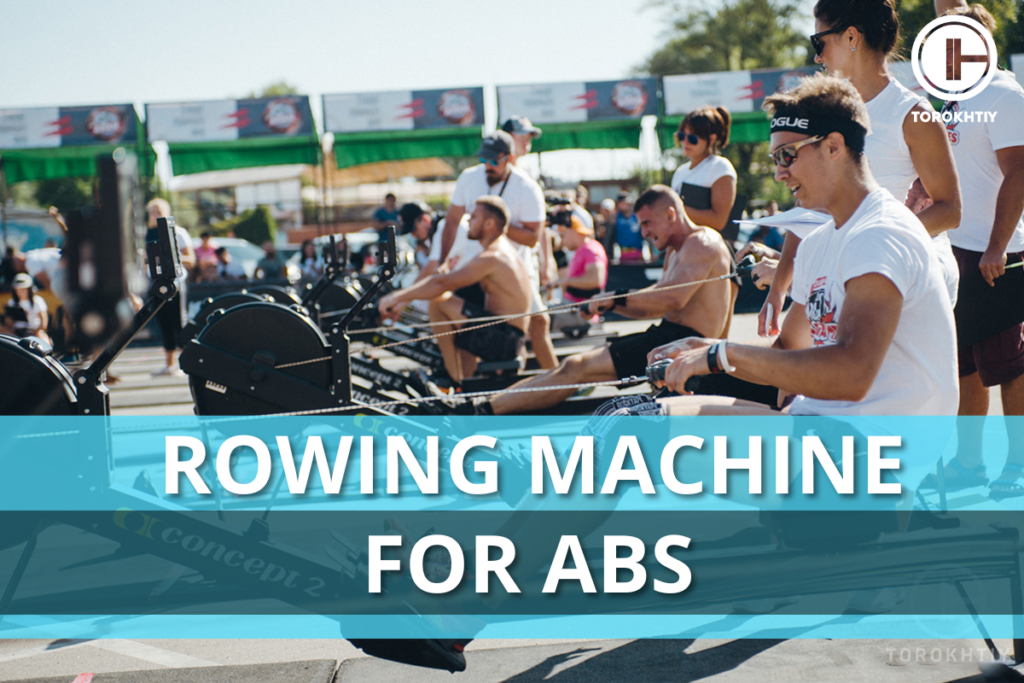
Intro To Rowing Abs Training
Before delving into the specific ways of utilizing a rowing machine, let’s look at the rowing movement and the muscles involved in this dynamic exercise. A rowing stroke can be broken down into four parts, with each one using different muscle groups:
1. The Catch
The catch marks the initial position of the rowing stroke. You should be leaning slightly forward whilst maintaining a neutral back position with your shins vertical. There should be around 6-8″ of space between your feet and the seat, with your heels slightly raised.
2. The Drive
During the Drive phase, start by extending your knees while simultaneously pushing the seat backward. Once your legs are fully extended, lean back slightly and open your hips. Keep your glutes activated at the top of the movement.
3. The Finish
To complete the stroke, pull the handle of the rowing machine towards your body, Aiming for a position just below your ribs. Throughout this phase, ensure that your shoulders are positioned behind your hips, maintaining proper alignment. The finish marks the culmination of the rowing movement, engaging key upper body muscles and emphasizing a strong and stable posture.
4. The Recovery
The recovery is the reverse of the drive phase. Flex your legs first whilst keeping your arms extended and back in a neutral position. Proceed to smoothly return to the catch position with a deliberate and controlled tempo.
Considering this, does the rowing machine work your abs? At each of these phases, your abdominals are engaged in different ways. Rowing doesn’t specifically target your ab muscles but can be used as an excellent exercise stimulus alongside the right weight training program and diet. After all, abs are built in the kitchen!
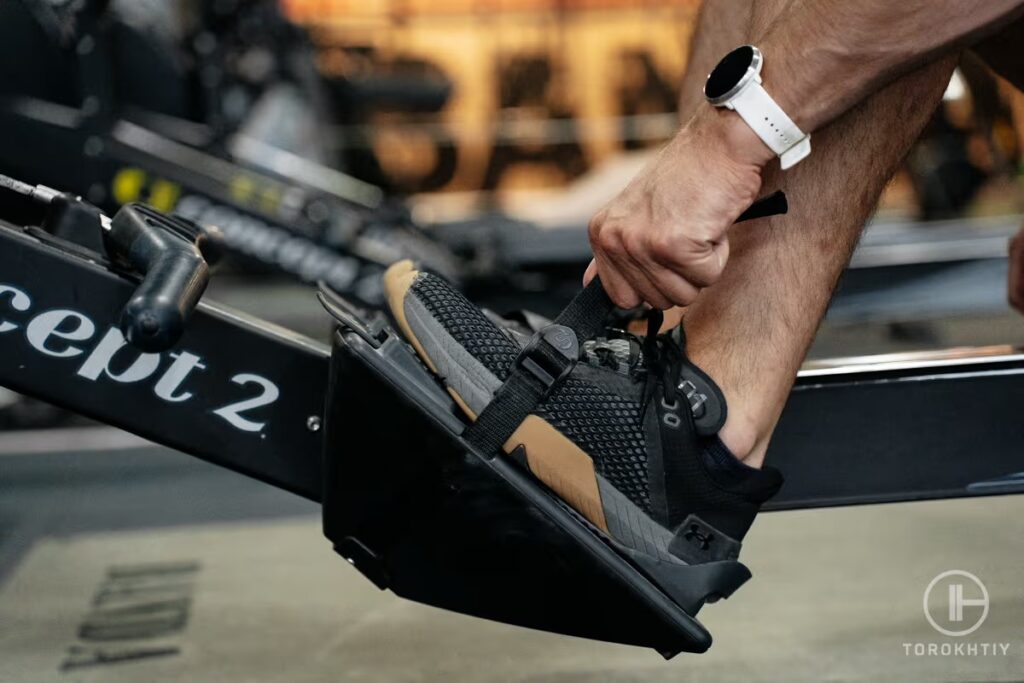
How To Effectively Engage Your Abs While Rowing?
If you want to properly engage your core when rowing follow the guide below. To ensure proper engagement of your core during rowing, adhere to the following guidelines, which explain how to utilize your abs in each phase
The Catch – At the starting position, engage your core as you lean forward to grab the rowing handle. Your body should feel tight, with your chest up and lats activated. Additionally, be mindful of your rib position; avoid flaring them when lifting your chest. Instead, ensure that your chest remains elevated while tucking your ribs down towards your pelvis. This alignment promotes a healthy and neutral spine, allowing your abdominal muscles to work efficiently.
The Drive – As you execute the powerful pull back by driving through your legs, be mindful of your core tightening. Your abdominal muscles will work vigorously to maintain a stable body position throughout this forceful phase. Emphasizing core engagement enhances the efficiency of the rowing motion.
The Finish – As you lean slightly back, your abs should be working to keep you from leaning too far back. By engaging your abs, you maintain a braced position that stabilizes your torso and ensures proper form. This not only enhances the effectiveness of the rowing stroke but also reduces the risk of straining your back.
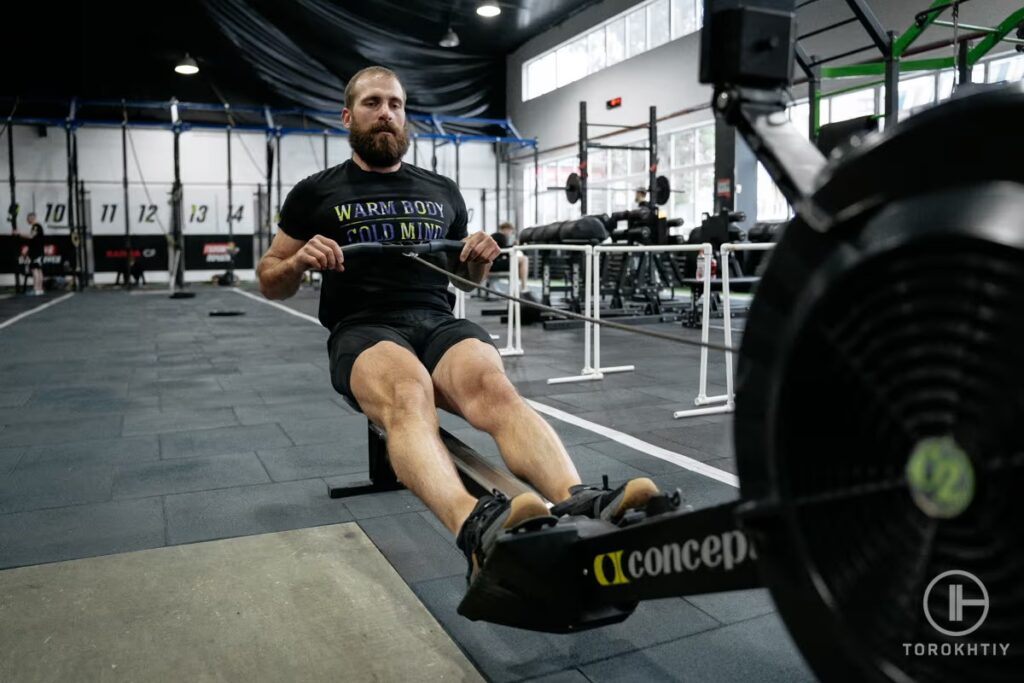
The Recovery – As you go back to the start position, your abs should remain flexed in order to bring your torso forward under control. Once you’ve reached the starting position, you can briefly relax before taking another breath to start again.
3 Tips On How To Row Effectively For Abs Training
To maximize the effectiveness of your abs training while rowing, it’s crucial to adhere to specific guidelines. Here are my top tips for rowing effectively to target your core:
✅ Maintain The Correct Body Position
Not keeping the correct body position leads to inefficient rowing, which in turn, leads to less ab activation and therefore development.
Focus on the correct technique cues like proper core bracing, keeping your chest up, head facing forward, and back neutral. Add a slight lean to the finish without overextending your hips and legs.
✅ Practice Maintaining A Good Tempo
Whilst you want to generate a good amount of power when rowing, you don’t want to rush. If your glutes keep slamming against the front of the rower or you feel that you’re jerking around, you’re probably going too fast.
Aim for a rowing stroke ratio of 1:2 – this means your recovery should be twice as long as the drive phase.
✅ Engage Your Entire Body To Row
Make sure to keep your hands and feet connected when rowing. If you feel that your posterior is getting ahead of your body, your upper half isn’t working as fast.
To fix this issue, focus on keeping your core engaged throughout the whole rowing stroke whilst using the technique cues I’ve described above.
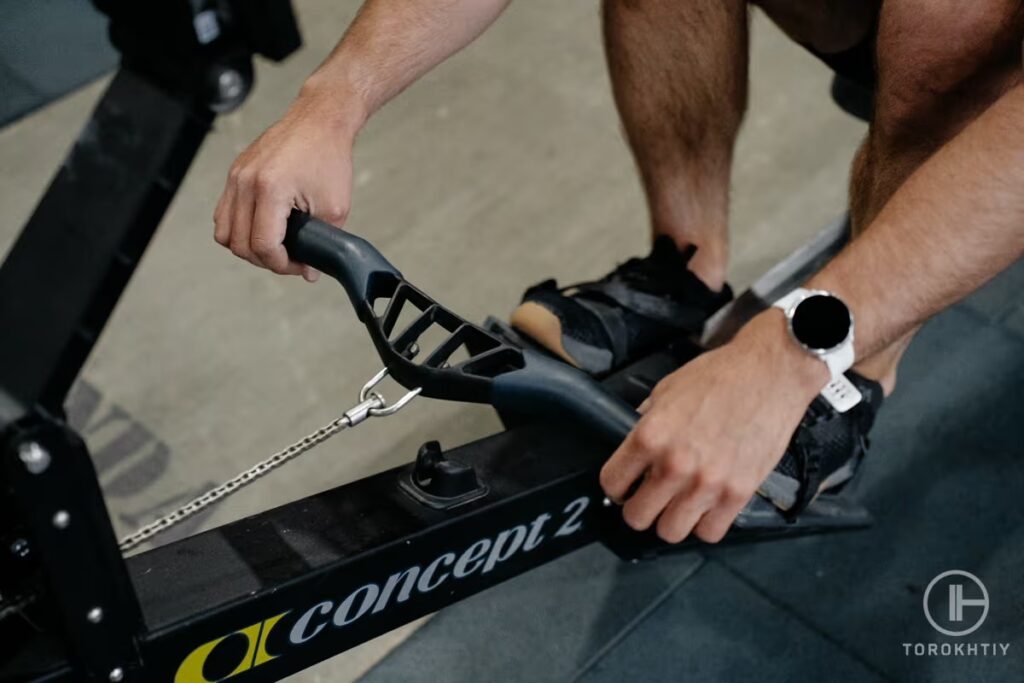
HIIT Rowing Workout For A Greater Calorie Burn
By combining repeated periods of intense exercise with rest, high intensity interval training (HIIT) is a great way to burn calories and have some fun. It also offers excellent benefits to overall rowing performance when used correctly.
When looking to burn calories, you want to aim for around 30 minutes of HIIT training. With this, you’ll need enough rest.
Whilst you can vary these numbers slightly depending on preference, start with a ratio of 1:1. This means one minute of high-intensity work with one minute of rest.
| Duration | Work | Rest |
|---|---|---|
| 30 minutes | 1 minute | 1 minute |
2 Rowing Machine Alternatives For Abs Training
Now I’ve answered the question ‘Is rowing good for abs?’, here are a couple of my recommended alternative ab exercises using a rowing machine.
Rower Ab Rollouts – The rowing seat can be used just like the ab wheel by utilizing the rail sliding motion. With your feet on the floor behind the rail, grasp the seat with two hands and use your core to move back and forth.
Mountain Climber Push-ups – Two-legged mountain climbers are another great alternative ab workout using the sliding seat. Place your feet on the seat and hands on the floor into a press-up position at the back. Bring your knees into your body and press down to the floor. Go back to the starting position and repeat.
Black Concept 2 Rowerg Rower – PM5
- Item dimensions: 96 L x 24 W x 14/20 H (depending on model) inches
- Item weight: 57 lbs/68 lbs
- Resistance system: Air
- Display: Digital
- Slide rail length: 54 inches
- Weight capacity: 500 lbs
- Compatibility: ErgData app
- Warranty: 5-year frame, 2-year parts
- Additional features: ANT+ & Bluetooth connectivity (heart rate devices), USB flash drive compatibility (data import/export), machine-to-machine racing mode
Concept2 Black RowErg Rower PM5 is a premium rower manufactured in the United States and built from quality materials. It combines an air resistance mechanism with a built-in damper to control the airflow when you row. This gives you more control over your resistance, with the amount of force increasing as you row harder.
The rower frame uses a combination of steel, aluminum, and plastic casing materials to give you a rower that weighs 57 pounds and supports up to 500 pounds of user weight. Other features include adjustable footrests, ergonomic rowing handles, and a foldable design that breaks into two pieces.
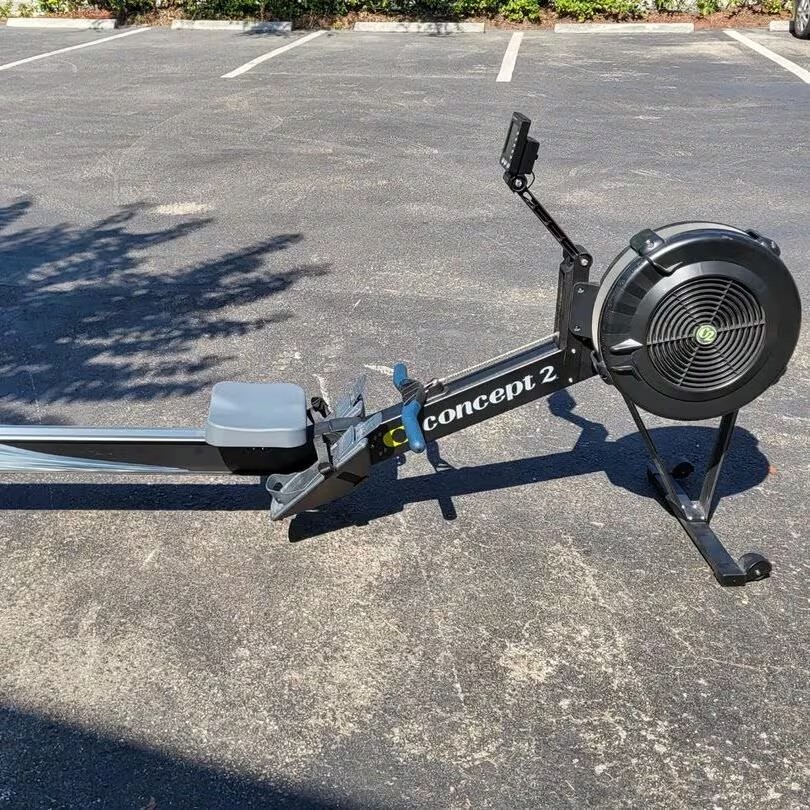
At the front of the frame, the advanced PM5 performance monitor offers an excellent range of workout options and metrics as you row. The screen displays your distance, time, strokes, pace, and projected completion time. Concept2 also offers five pre-set rowing workouts to choose from if you prefer more structure.
A unique feature of the PM5 is the five games that operate using your rowing motion. This provides you with external motivation is a really good feature not seen on many other rowing machines.
FAQ
Is Rowing Good For Belly Fat?
Rowing provides an excellent cardio option that burns a lot of calories when used correctly. This increased calorie burning can help to burn stubborn belly fat when used alongside the right diet and lifestyle choices.
Can I Get Toned From Using A Rowing Machine?
During a row, your upper body works to pull the handle backward whilst your legs push against the foot pads. This makes rowing a low-impact cardio activity that works the muscles in both your upper and lower body.
Using a rowing machine regularly alongside weight training and a calorie deficit can help to tone your body, but it can’t target specific areas.
Can I Get A 6 Pack From Rowing?
You can get a 6 pack from rowing just like you can from doing many other activities. Getting a six pack involves consistently sticking to the right diet, performing regular abdominal exercises, and doing cardiovascular exercises such as rowing.
Conclusion
In conclusion, rowing machines effectively engage your abs with proper technique and core activation at each stage. However, to achieve defined abs, combine rowing with a well-structured plan that includes strength training, and a calorie deficit – high protein nutrition approach especially if you have excessive subcutaneous fat.
Do you use the rowing machine for abs? What’s your favorite rowing workout? Try the tips I’ve mentioned above and let me know if it made a difference!
Also read:
Referenses:
- Indoor rower // Wikipedia: https://en.m.wikipedia.org/wiki/Indoor_rower
- Muscle action and stress on the ribs in rowing // Science Direct: https://www.sciencedirect.com/science/article/abs/pii/S1466853X00900233
- Changes in intra-abdominal pressure // Journal of Applied Physiology: https://journals.physiology.org/doi/full/10.1152/jappl.2000.89.3.967
- How to Use a Rowing Machine // VeryWellFit: https://www.verywellfit.com/how-to-use-a-rowing-machine-1230825
- High-Intensity Interval Training // WebMD: https://www.webmd.com/fitness-exercise/a-z/high-intensity-interval-training-hiit
- High-Intensity Interval Training and Sprint-Interval Training // FrontierSin: https://www.frontiersin.org/articles/10.3389/fphys.2021.803430/full
- Diets and body composition // BioMedCentral: https://jissn.biomedcentral.com/articles/10.1186/s12970-017-0174-y
- Photos made by Torokhtiy Media Team.
Why Trust Us?
With over 20 years in Olympic weightlifting, strength training, nutrition coaching, and general fitness our team does its best to provide the audience with ultimate support and meet the needs and requirements of advanced athletes and professional lifters, as well as people who strive to open new opportunities and develop their physical capabilities with us.
By trusting the recommendations of our certified experts in coaching, nutrition, and sports training programming, as well as scientific consultants, and physiotherapists, we provide you with thorough, well-considered, and scientifically proven content. All the information given in the articles concerning workout programming, separate exercises, and athletic performance, in general, is based on verified data.
The product testing process is described in more detail here.
Author: Ihor Shymechko
Pro Olympic Weightlifter, Coach
Best Results: Snatch – 208 kg,
C&J – 240 kg
Ihor has been a professional weightlifter since 1996, boasting over two decades of competition experience. His notable achievements include clinching the European Championship in 2009 and securing a silver medal in the 105kg division at the Senior World Championships in 2011. Ihor represented his country in the 2008, 2012, and 2016 Summer Olympics. After retiring from competitive weightlifting, he transitioned to coaching, leveraging his vast experience to guide athletes who now compete on both national and international stages.
Reviewed by: Dina Al-Rubaye
Professional Nutritionist and Certified Coach
Personal trainer since 2017
Dina Al-Rubaye, a 26-year-old from Iraq, is a strength and conditioning coach and a sports nutrition specialist. She studied and later earned a degree in Nutrition and Dietetics from the American University of Beirut in Lebanon. She worked in helping people with their diets, but she never let go of her passion for long-distance running and competing in marathons.




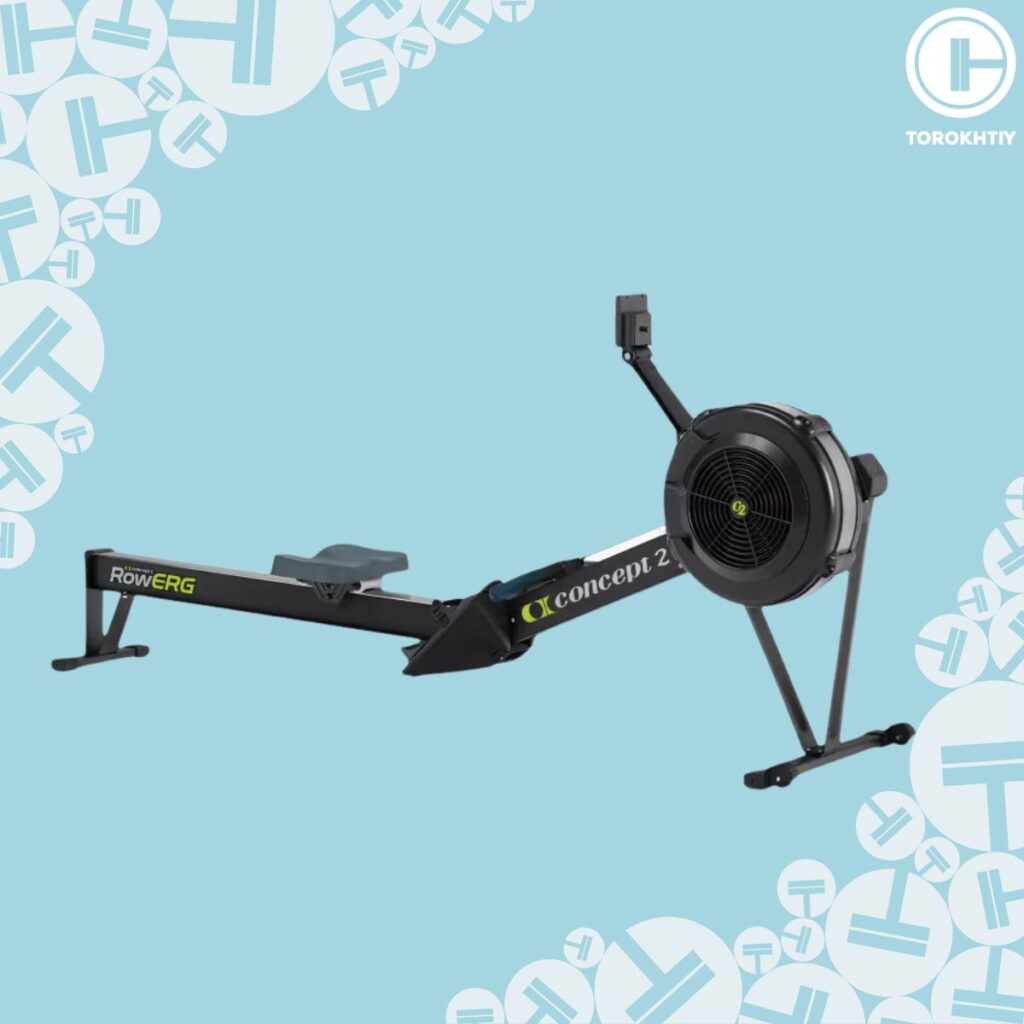
Still have questions after reading our article? Unlock your full potential by engaging with our experts and community! Don’t hesitate — leave a comment below and Ihor Shymechko will provide a personalized answer and insights to help you reach your goals.